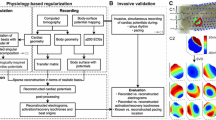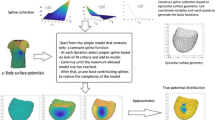Abstract
In inverse electrocardiography, the goal is to estimate cardiac electrical sources from potential measurements on the body surface. It is by nature an ill-posed problem, and regularization must be employed to obtain reliable solutions. This paper employs the multiple constraint solution approach proposed in Brooks et al. (IEEE Trans Biomed Eng 46(1):3–18, 1999) and extends its practical applicability to include more than two constraints by finding appropriate values for the multiple regularization parameters. Here, we propose the use of real-valued genetic algorithms for the estimation of multiple regularization parameters. Theoretically, it is possible to include as many constraints as necessary and find the corresponding regularization parameters using this approach. We have shown the feasibility of our method using two and three constraints. The results indicate that GA could be a good approach for the estimation of multiple regularization parameters.





Similar content being viewed by others
References
Ahmad GF, Brooks DH, MacLeod RS (1998) An admissible solution approach to inverse electrocardiography. Ann Biomed Eng 26(2):278–292
Aydin U, Dogrusoz YS (2011) A Kalman filter based approach to reduce the effects of geometric errors and the measurement noise in the inverse ECG problem. Med Biol Eng Comput 49(9):1003–1013
Berrier KL, Sorensen DC, Khoury DS (2004) Solving the inverse problem of electrocardiography using a Duncan and Horn formulation of the Kalman filter. IEEE Trans Biomed Eng 51(3):507–515
Brooks DH, Ahmad GF, MacLeod RS (1994) Multiply constrained inverse electrocardiography: combining temporal, multiple spatial, and iterative regularization. In: Proceedings of the 16th annual international conference of the IEEE EMBS
Brooks DH, Ahmad GF, MacLeod RS, Maratos GM (1999) Inverse electrocardiography by simultaneous imposition of multiple constraints. IEEE Trans Biomed Eng 46(1):3–18
Ghodrati A, Brooks DH, Tadmor G, MacLeod RS (2006) Wavefront-based models for inverse electrocardiography. IEEE Trans Biomed Eng 53(9):1821–1831
Greensite F (2003) The temporal prior in bioelectromagnetic source imaging problems. IEEE Trans Biomed Eng 50(10):1152–1159
Gulrajani RM (1998) The forward and inverse problems of electrocardiography. IEEE Eng Med Bio Mag 17(5):84–101,122
Hansen PC (2000) The L-curve and its use in the numerical treatment of inverse problems. In: Johnston PR (ed) Computational inverse problems in electrocardiology. WIT Press, Southampton, pp 119–142
Herrera F, Lozano M, Verdegay JL (1998) Tackling real coded genetic algorithms: operators and tools for behavioural analysis. Artif Intell Rev 12(4):265–319
Hren R, Stroink G (2001) Noninvasive characterisation of multiple ventricular events using electrocardiographic imaging. Med Biol Eng Comput 39:447–454
Jiang M, Xia L, Shou G (2006) The use of genetic algorithms for solving the inverse problem of electrocardiography. In: Proceedings of the 28th annual international conference of the IEEE EMBS
Jiang M, Xia L, Shou G, Tang M (2007) Combination of the LSQR method and a genetic algorithm for solving the electrocardiography inverse problem. Phys Med Biol 52(5):1277–1294
Jiang M, Xia L, Huang W, Shou G, Liu F, Crozier S (2009) The application of subspace preconditioned LSQR algorithm for solving the electrocardiography inverse problem. Med Eng Phys 31(8):979–985
Jiang M, Zhu L, Wang Y, Xia L, Shou G, Liu F, Crozier S (2011) Application of kernel principal component analysis and support vector regression for reconstruction of cardiac transmembrane potentials. Phys Med Biol 56(6):1727–1742
Johnston PR, Gulrajani RM (1997) A new method for regularization parameter determination in the inverse problem of electrocardiography. IEEE Trans Biomed Eng 44(1):19–39
Liu C, He B (2011) Noninvasive estimation of global activation sequence using the extended Kalman filter. IEEE Trans Biomed Eng 58(3):541–549
Macleod RS, Lux RL, Tacardi B (1998) A possible mechanism for electrocardiographically silent changes in cardiac repolarization. J Electrocardiol 30:114–121
Macleod RS, Johnson CR (1993) Map3d: interactive scientific visualization for bioengineering data. In: Proceedings of the 15th annual international conference of the IEEE EMBS
Oster HS, Rudy Y (1992) Use of temporal information in the regularization of the inverse problem of electrocardiography. IEEE Trans Biomed Eng 39(1):65–75
Potse M, Dube B, Vinet A (2009) Cardiac anisotropy in boundary-element models for the electrocardiogram. Med Biol Eng Comput 47:719–729
Shou G, Jiang M, Xia L, Wei Q, Liu F, Crozier S (2006) A comparison of different choices for the regularization parameter in inverse electrocardiography models. In: Proceedings of the 28th annual international conference of the IEEE EMBS
Stanley PC, Pilkington TC, Morrow MN (1986) The effects of thoracic inhomogeneities on the relationship between epicardial and torso potentials. IEEE Trans Biomed Eng 33(3):273–284
Tikhonov AN, Arsenin VY (1977) Solution of ill-posed problems. Winston and Sons, Washington DC
Acknowledgments
This work was supported by The Scientific and Technological Research Council of Turkey, grant number 105E070.The authors would like to thank Dr. R. S. Macleod from the University of Utah, Nora Eccles Harrison Cardiovascular Research and Training Institute, for the data used in this study. This work was made possible in part by software (Map3d) from the NIH/NCRR Center for Integrative Biomedical Computing, P41-RR12553-10.
Author information
Authors and Affiliations
Corresponding author
Rights and permissions
About this article
Cite this article
Serinagaoglu Dogrusoz, Y., Mazloumi Gavgani, A. Genetic algorithm-based regularization parameter estimation for the inverse electrocardiography problem using multiple constraints. Med Biol Eng Comput 51, 367–375 (2013). https://doi.org/10.1007/s11517-012-1005-6
Received:
Accepted:
Published:
Issue Date:
DOI: https://doi.org/10.1007/s11517-012-1005-6




